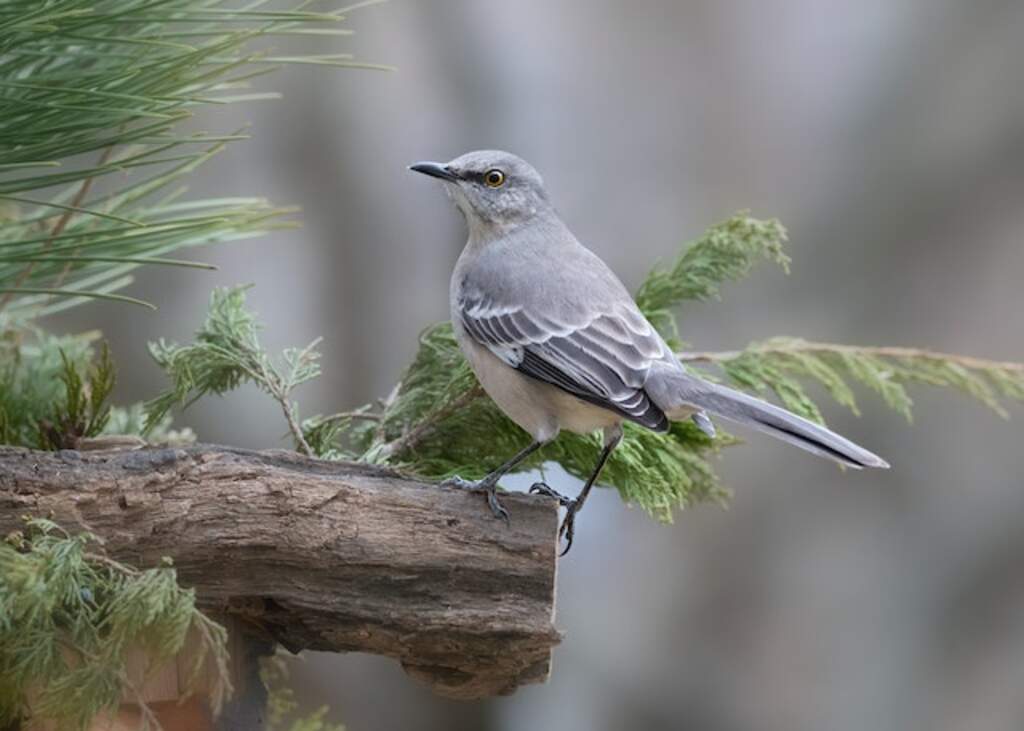Meet the Northern Mockingbird, the Florida state bird, a remarkable species known for its melodious songs and unique behaviors. In this article, we will explore the fascinating world of the Northern Mockingbird, from its physical characteristics to its role in the ecosystem. Get ready to meet this magnificent bird and discover why it holds such an important place in the hearts of Floridians.
Table of Contents
- 1 Overview of the Northern Mockingbird
- 2 Physical Characteristics
- 3 Habitat and Distribution
- 4 Northern Mockingbird’s Diet
- 5 Northern Mockingbird’s Songs and Calls
- 6 Intelligence and problem-solving abilities
- 7 Reproduction of the Northern Mockingbird
- 8 The Spiritual Significance of the Northern Mockingbird
- 9 How to Attract Northern Mockingbirds
- 10 Threats and Conservation
- 11 FAQs About The Florida State Bird: Northern Mockingbird
- 11.1 What is the Florida state bird?
- 11.2 Why was the Northern Mockingbird chosen as the Florida state bird?
- 11.3 What does the Northern Mockingbird look like?
- 11.4 Where can I find the Northern Mockingbird in Florida?
- 11.5 What does the Northern Mockingbird eat?
- 11.6 Is the Northern Mockingbird in danger?
- 12 Conclusion
- 13 Author
Overview of the Northern Mockingbird
The Northern Mockingbird (Mimus polyglottos) is a remarkable bird species native to North America. This medium-sized songbird is known for its exquisite vocalizations and unique ability to mimic the sounds of other birds and even non-avian sounds, such as car alarms and cell phone ringtones. The Northern Mockingbird is a member of the Mimidae family, which also includes thrashers and catbirds.
Why is the Northern Mockingbird Florida’s State Bird?
The Northern Mockingbird is a beloved bird species that is abundant throughout the state of Florida. In 1927, it was officially designated as Florida’s state bird, but why was this bird specifically chosen for this honor? The solution can be attributed to a combination of factors.
At the time of the designation, the Northern Mockingbird was already well-established as a popular and recognizable bird in the state of Florida.
Its melodic and varied song, which can include imitations of other bird species and even human-made sounds, was a source of delight for many Floridians.
However, other factors may have also played a role in the decision, such as the bird’s adaptability and resilience in the face of environmental challenges.
Regardless of the precise reasons for its selection, the Northern Mockingbird remains an important and beloved symbol of Florida and its unique natural heritage.
Brief History Behind the Decision
The decision to select the Northern Mockingbird as Florida’s state bird was based on several factors. Its stunning appearance and remarkable resilience in the face of environmental challenges made it an ideal symbol for a state that was still recovering from the devastating effects of early 20th-century hurricanes.
In addition, there was a growing movement across the United States to designate state birds as a way of promoting conservation and awareness of local wildlife.
As one of the first states to adopt an official state bird, Florida naturally gravitated towards the Northern Mockingbird due to its adaptability and popularity with Floridians.
Physical Characteristics
The Northern Mockingbird, Florida’s state bird, is a fascinating creature that possesses a unique set of physical characteristics that set it apart from other birds. In this section, we will delve into its appearance, size, behavior, habits, and adaptation to Florida’s environment.
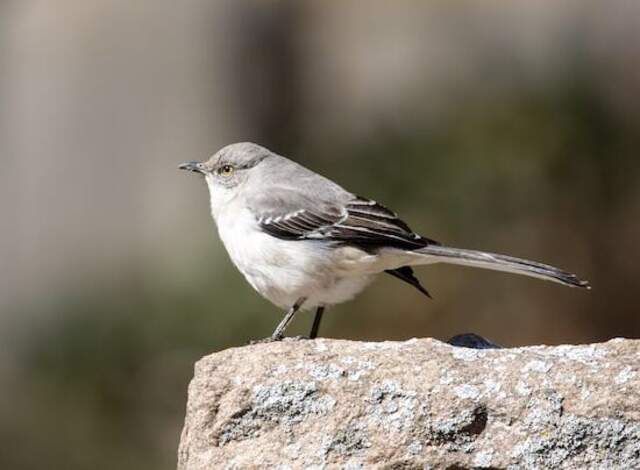
| Scientific name | Length | Weight | Wingspan |
|---|---|---|---|
| Mimus polyglottos | 8.5 – 10 inches | 1.4 – 2 ounces | 12 – 13 inches |
Appearance and Size
The Northern Mockingbird is a medium-sized bird, measuring approximately 8.5 to 10 inches in length, with a wingspan of 12 to 13 inches. The bird’s plumage is predominantly gray, with white undersides and white wing patches that are visible in flight.
The Northern Mockingbird is a sexually monomorphic species, meaning that both males and females look similar. One of the distinctive features of the Northern Mockingbird is its long tail, which is almost as long as its body.
The bird’s bill is thin and slightly curved, allowing it to forage for insects and berries with precision. The Northern Mockingbird also has a thin, black mask around its eyes, which gives it a distinctive appearance.
Behavior and Habits
The Northern Mockingbird is a vocal bird and is known for its ability to mimic the sounds of other birds and animals. It can also mimic the sounds of car alarms, cell phones, and even human speech. The bird’s ability to mimic sounds is believed to be a way of attracting a mate or establishing its territory.
Northern Mockingbirds are also territorial birds and will defend their territory against other birds, including other Northern Mockingbirds. They will engage in aggressive behavior, including chasing and even attacking intruders.
However, outside of breeding season, Northern Mockingbirds can be seen in loose flocks. The Northern Mockingbird is a diurnal bird, meaning that it is active during the day and rests at night. It is an omnivore, feeding on a variety of foods, including insects, berries, and fruits.
Adaptation to Florida’s Environment
The Northern Mockingbird is a common sight throughout Florida and has adapted well to the state’s diverse environment. It is found in a variety of habitats, including suburban areas, forests, and scrublands.
One of the reasons for the bird’s success in Florida is its adaptability to changing environments. It can thrive in both natural and urban environments, making it a common sight in parks and gardens throughout the state.
The Northern Mockingbird is also a resilient bird, capable of surviving in harsh conditions. It has been known to survive extreme temperatures and droughts, making it a hardy bird that can withstand the challenges of Florida’s environment.
Overall, the Northern Mockingbird is a fascinating bird that possesses a unique set of physical characteristics and behavior. Its ability to adapt to Florida’s diverse environment and survive in harsh conditions has made it a common sight throughout the state.
| Physical Characteristics | Appearance and Size | Behavior and Habits | Adaptation to Florida’s Environment |
|---|---|---|---|
| Weight | 40–60 grams | Singing | Eating insects and berries |
| Wingspan | 31-34 cm | Territorial | Able to thrive in urban areas |
| Length | 20-28 cm | Mimicking sounds | Withstanding Florida’s heat |
| Coloration | Gray and white | Night singing | Tolerance of human activity |

Habitat and Distribution
Where can Northern Mockingbirds be found in Florida?
Northern Mockingbirds can be found throughout Florida, from the panhandle to the Keys. They are a year-round resident in the state, and can often be seen in urban and suburban areas, as well as rural habitats.
These birds prefer open areas with scattered trees, such as parks, gardens, fields, and woodland edges. They are also commonly found in residential areas, including backyards and gardens.
While Northern Mockingbirds can be found in a variety of habitats in Florida, they do have a preference for certain types of trees.
Mockingbirds are attracted to trees and shrubs that provide cover for nesting and perching, as well as a source of food. Some of their favorite trees include:
- Live oak
- Red cedar
- Wax myrtle
- Yaupon holly
- Southern magnolia
These trees are often found in the same types of habitats where mockingbirds can be found, such as parks, gardens, and woodland edges.
Northern Mockingbird’s habitat preferences
Northern Mockingbirds are a common bird species found in a variety of habitats. They are adaptable and can live in different environments, ranging from urban to rural settings. They prefer open areas with scattered trees, and can often be found in parks, gardens, fields, and woodland edges.
Northern Mockingbirds are also commonly found in residential areas, including backyards and gardens. These birds typically prefer areas with low to moderate vegetation cover, as they need some cover for nesting and perching.
They are also attracted to areas with a diverse range of plant species, as this provides a variety of food sources. Northern Mockingbirds feed on a wide range of insects, fruits, and berries, and also consume nectar from flowers.
| Habitat Preferences | Description |
|---|---|
| Habitat Range | Northern Mockingbirds are found in a variety of habitats ranging from urban to rural settings. |
| Preferred Environment | They prefer open areas with scattered trees, and can often be found in parks, gardens, fields, and woodland edges. |
| Residential Areas | They are commonly found in residential areas, including backyards and gardens. |
| Vegetation Cover | They typically prefer areas with low to moderate vegetation cover, as they need some cover for nesting and perching. |
| Plant Species | They are attracted to areas with a diverse range of plant species, as this provides a variety of food sources. |
| Diet | Northern Mockingbirds feed on a wide range of insects, fruits, and berries, and also consume nectar from flowers. |
Migration patterns
Northern Mockingbirds in Florida are non-migratory, meaning they do not typically migrate to other areas during the winter months. Instead, they remain in the state year-round, taking advantage of the mild climate and abundance of food sources.
However, some individuals may move short distances during the winter months in search of better food sources or more favorable conditions.
Overall, Northern Mockingbirds are a common bird species found throughout Florida. They are adaptable and can be found in a range of habitats, from urban to rural environments.
They prefer areas with low to moderate vegetation cover and a diverse range of plant species. In Florida, they are non-migratory and can be seen year-round.
A table for the migration patterns of Northern Mockingbirds:
| Season | Location |
|---|---|
| Winter | Southern Florida, Mexico, Central America, Caribbean |
| Spring | Southern Florida, Gulf Coast, Southeastern U.S. |
| Summer | Throughout Florida and much of the eastern U.S. |
| Fall | Southern Florida, Gulf Coast, Mexico, Central America, Caribbean |
Note: Migration patterns can vary depending on factors such as weather patterns and food availability. This table provides a general overview of typical migration patterns for Northern Mockingbirds.
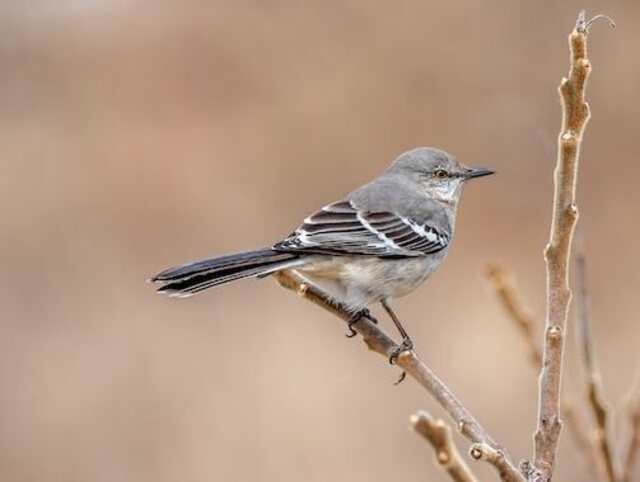
Northern Mockingbird’s Diet
The Northern Mockingbird is an omnivorous bird species that feeds on a wide variety of foods. This section will provide detailed information on the types of food that Northern Mockingbirds consume, their hunting and feeding behaviors, and their role in the ecosystem.
Types of food they eat
Northern Mockingbirds are opportunistic feeders and will consume anything they can find, including insects, spiders, earthworms, snails, and other small invertebrates. They also eat berries, fruits, and seeds, especially during the winter months when insects are less abundant. Some of their favorite fruits include strawberries, blackberries, and blueberries. They also eat the fruits of trees like dogwood, holly, and elderberry.
In addition to insects and fruits, Northern Mockingbirds also eat small reptiles and amphibians, such as lizards, frogs, and toads. They are known to crack open the shells of snails and clams with their strong beaks to access the soft flesh inside.
Hunting and feeding behaviors
Northern Mockingbirds are active hunters and will search for food on the ground or in trees and shrubs. They use their keen eyesight to spot potential prey and will swoop down to grab it with their beaks. They are also skilled at catching insects in mid-air, using their agile flight skills to chase and capture flying insects.
When it comes to feeding, Northern Mockingbirds are known for their unique feeding behavior called “gaping.” They use their beaks to create a small hole in the skin of fruits, such as figs, and then use their tongues to extract the juice from the fruit.
Role in the ecosystem
As an important member of the ecosystem, the Northern Mockingbird plays a vital role in controlling insect populations. They are also important seed dispersers, helping to spread the seeds of fruits and berries that they consume. This helps to ensure the survival and diversity of plant species in their habitat.
In addition, Northern Mockingbirds are also important indicators of ecosystem health. Because they feed on a variety of foods, including insects and fruits, changes in their populations can be a sign of changes in the ecosystem. For example, a decline in the number of Northern Mockingbirds could indicate a decline in the number of insects in the ecosystem, which could have serious implications for other species that rely on insects for food.
| Northern Mockingbird’s Diet | Examples |
|---|---|
| Insects | spiders, earthworms, snails, and other small invertebrates |
| Fruits | strawberries, blackberries, blueberries, figs, dogwood, holly, elderberry |
| Small reptiles and amphibians | lizards, frogs, toads |
| Other | seeds, especially during the winter months when insects are less abundant |
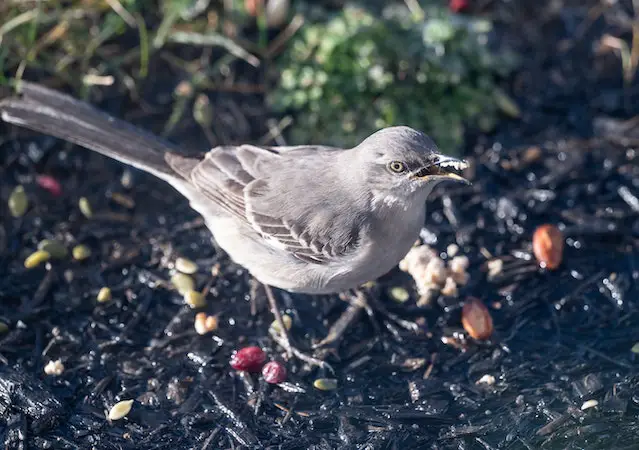
Northern Mockingbird’s Songs and Calls
The Northern Mockingbird is renowned for its remarkable ability to mimic the songs and calls of other birds, as well as other sounds in its environment, such as car alarms and ringing phones. These birds are accomplished vocalists, with a wide range of musical abilities that vary by individual and region.
Why are their songs so important?
Mockingbird songs are important for a number of reasons. Firstly, they play a crucial role in courtship and mate selection. Males will sing complex and varied songs to attract females, who are known to prefer males with larger repertoires.
Additionally, mockingbirds use their songs to establish territories and communicate with other birds in their area. They also use specific calls to warn of predators, and their mimicry abilities allow them to imitate the calls of potential predators to scare away other birds.
Types of songs and calls
Mockingbirds have a vast repertoire of over 50 different songs and over 50 calls that they use in different contexts. Some of the most common types of songs include the following:
- Repetitive songs: These songs consist of simple, repeated phrases that the bird will sing over and over again. These are often used for territorial defense or to attract a mate.
- Warbling songs: These are more complex songs that involve trills and varying notes. These are often used in courtship displays.
- Mimicry: Mockingbirds are able to mimic a wide variety of sounds, including the calls of other birds, insects, dogs barking, sirens, and even man-made sounds. This ability is thought to help them establish their dominance over other birds and impress potential mates.
In addition to their songs, mockingbirds also use a variety of calls to communicate with other birds. Some of the most common calls include the following:
- Chatter: A rapid series of high-pitched notes that mockingbirds use to signal aggression or excitement.
- Whistle: A clear, sharp call that is used for warning other birds of predators or danger.
- Begging call: A high-pitched, plaintive call that young birds use to beg for food from their parents.
The significance of their singing in Florida’s culture
Mockingbirds are an important part of Florida’s culture, and their singing is deeply ingrained in the state’s folklore and literature. The Northern Mockingbird was designated as the official state bird of Florida in 1927, in recognition of its status as a common and beloved bird throughout the state.
One of the most famous examples of mockingbird song in literature is in Harper Lee’s classic novel “To Kill a Mockingbird,” In which the mockingbird serves as a metaphor for innocence and the destruction of beauty without reason.
In Florida, mockingbirds are also celebrated for their role in preventing orange groves from being infested by insects, as they eat a large number of pests that can damage crops.
Overall, the Northern Mockingbird’s songs and calls are a remarkable example of the diversity and complexity of bird vocalizations.
Through their songs and mimicry abilities, these birds are able to communicate with each other, attract mates, and defend their territories in a way that is truly unique and fascinating.
Table: Types of Mockingbird Songs
| Type of Song | Description |
|---|---|
| Repetitive songs | Simple, repeated phrases that are used for territorial defense or to attract a mate. |
| Warbling songs | Complex songs that involve trills and varying notes. Used in courtship displays. |
| Mimicry | Ability to mimic a wide |
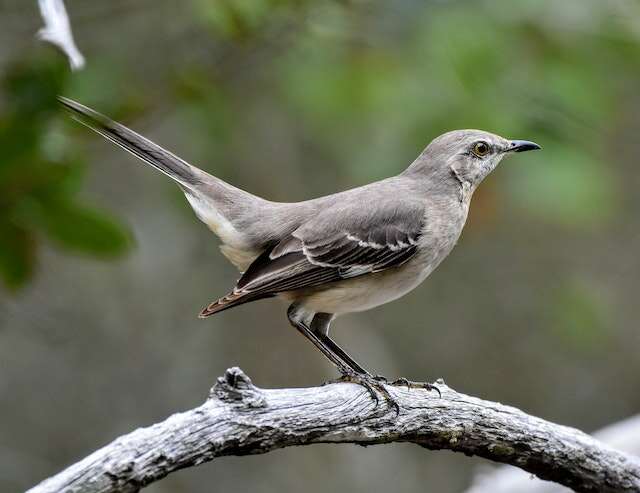
Intelligence and problem-solving abilities
Studies have shown that Northern Mockingbirds are capable of recognizing individual humans and can differentiate between the sounds of different bird species. In one study, researchers found that mockingbirds were able to recognize and respond differently to the songs of other mockingbirds that were from different regions of the country.
This ability to recognize and differentiate between different sounds and species is a testament to their impressive cognitive abilities. Northern Mockingbirds are also known for their problem-solving abilities.
In one study, researchers observed a mockingbird using a twig to extract insects from a small crevice in a tree. This type of problem-solving behavior is not commonly observed in birds and is a testament to the adaptability and intelligence of these birds.
Territoriality and aggression
Northern Mockingbirds are highly territorial birds that will aggressively defend their territory from other birds, animals, and even humans. During the breeding season, males will establish a territory and defend it from other males. They will use a variety of vocalizations, including mimicking other bird songs, to intimidate intruders and warn them away.
Mockingbirds are also known for their aggressive behavior towards potential predators. They will attack and harass larger birds, such as hawks and crows, to drive them away from their territory. This aggressive behavior is believed to be an adaptation to protect their young and defend their territory.
Social behavior and communication
While Northern Mockingbirds are highly territorial, they are also social birds that form bonds with their mate and their offspring. Mating pairs will stay together for multiple breeding seasons and will work together to defend their territory and raise their young.
Mockingbirds are also highly vocal birds that use a variety of calls and songs to communicate with other birds. They are able to mimic the songs of other birds, and will often incorporate these songs into their own repertoire.
This ability to mimic other birds is believed to be a form of communication that helps mockingbirds establish social hierarchies and attract mates.
| Behavior/Personality | Description |
|---|---|
| Intelligence and problem-solving abilities | Northern Mockingbirds can recognize individual humans, differentiate between different bird species, and mimic a variety of sounds including other bird songs and even human-made sounds. They also exhibit problem-solving behavior. |
| Territoriality and aggression | Northern Mockingbirds are highly territorial birds that will aggressively defend their territory from other birds, animals, and humans. They use a variety of vocalizations to intimidate intruders and protect their young. |
| Social behavior and communication | Northern Mockingbirds form bonds with their mate and offspring, and work together to defend their territory and raise their young. They are highly vocal birds that use a variety of calls and songs to communicate, including mimicking the songs of other birds to establish social hierarchies and attract mates. |
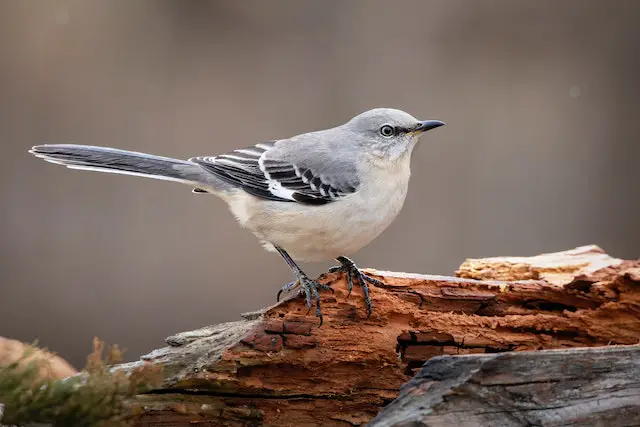
Reproduction of the Northern Mockingbird
The Northern Mockingbird is a highly adaptable bird that breeds across a wide range of habitats, from urban parks and gardens to rural fields and forests. Here, we will delve into the breeding behavior, nesting habits, incubation period, fledgling period, and reproductive success of these fascinating birds.
Breeding behavior and nesting
Northern Mockingbirds usually mate for life, and pairs will often defend their territories together. Males will establish their territories by singing from prominent perches, such as treetops or power lines. They will also display their wings and tails to attract females. After the formation of a pair, they will work together to construct a nest.
Northern Mockingbirds build their nests in a variety of locations, including trees, shrubs, and vines. They prefer to build their nests in dense vegetation, where they can be well-concealed from predators. The nests are made of twigs, grasses, and leaves, and are lined with softer materials, such as hair and feathers.
Incubation and fledgling period
The female Northern Mockingbird will lay a clutch of 2–6 eggs, which she will incubate for about 11-14 days. During this time, the male will continue to defend the territory and bring food to the female. After the eggs hatch, the mother and father will alternate in providing food for the offspring.
The chicks will leave the nest when they are about 10-15 days old. However, they will continue to be dependent on their parents for food and protection for several weeks after leaving the nest. During this time, the parents will teach the chicks how to find food and defend themselves.
Reproductive success
The reproductive success of Northern Mockingbirds varies depending on a number of factors, including habitat quality, food availability, and predator abundance. In general, however, these birds have high reproductive success rates.
Studies have shown that Northern Mockingbirds are able to raise multiple broods in a single breeding season. They are also able to adapt their breeding behavior to changing environmental conditions, such as drought or the availability of food.
This adaptability allows them to thrive in a variety of habitats, and helps to ensure their long-term survival.
| Aspect | Description |
|---|---|
| Breeding season | Late winter to early summer |
| Breeding behavior | Monogamous pair bonding, male singing to attract females |
| Nesting | Cup-shaped nests built in trees, shrubs, or vines, often hidden |
| Eggs | Clutches of 2-6 blue or greenish-blue eggs, incubated by female for about 12-13 days |
| Fledging | Young birds leave the nest after about 10-15 days, but may be fed by parents for several more weeks |
| Reproductive success | Varies by location and year, affected by factors such as predation, food availability, and weather conditions |

The Spiritual Significance of the Northern Mockingbird
The Northern Mockingbird holds great spiritual significance in various cultures and belief systems. Here, we will explore the symbolism of this majestic bird, its spiritual meanings and interpretations, and its importance in literature and the arts.
Symbolism in different cultures
In Native American culture, the Northern Mockingbird symbolizes creativity and curiosity. It is believed to bring new ideas and inspiration to those who encounter it. Additionally, some Native American tribes see the bird as a symbol of self-expression and communication.
In Christianity, the mockingbird is often associated with resurrection and renewal. This symbolism is derived from the bird’s ability to mimic the songs of other birds and create new melodies. The mockingbird is also considered a symbol of innocence and purity.
In Chinese culture, the mockingbird is seen as a symbol of happiness and good fortune. It is believed that the bird’s song brings joy and luck to those who hear it.
Spiritual meanings and interpretations
The Northern Mockingbird is often associated with spiritual growth and development. Its ability to mimic other birds’ songs and create new ones is seen as a symbol of adaptability and creativity.
The bird’s beautiful singing voice is also believed to have healing powers and can bring peace and calm to the mind and soul.
Some people believe that encountering a Northern Mockingbird is a sign of spiritual awakening or a message from the universe.
It may be a reminder to stay open to new experiences, express oneself freely, and embrace change.
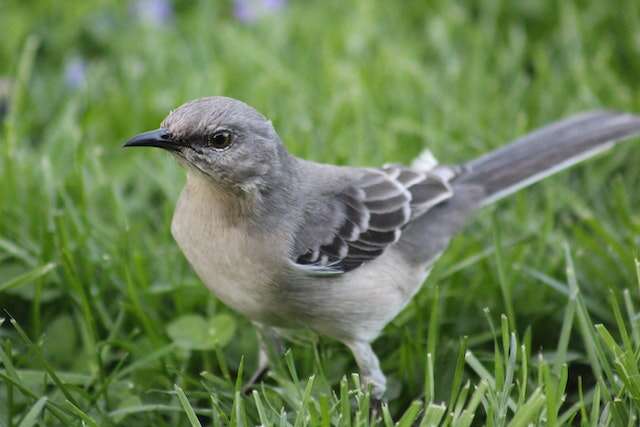
How to Attract Northern Mockingbirds
If you want to attract Northern Mockingbirds to your yard or garden, here are some tips:
- Provide Food: Northern Mockingbirds are omnivores and eat a variety of foods including insects, fruits, and berries. You can attract them by providing a bird feeder with fruits such as grapes, berries, and chopped apples. You can also plant berry-producing trees and shrubs such as holly, sumac, and elderberry.
- Provide Water: Northern Mockingbirds need water for drinking and bathing. You can provide them with a bird bath or fountain.
- Create Habitat: Northern Mockingbirds like open spaces with low vegetation for nesting and perching. You can create habitat for them by planting low-growing bushes such as hawthorn and juniper.
By following these tips, you can create a welcoming environment for Northern Mockingbirds in your backyard.
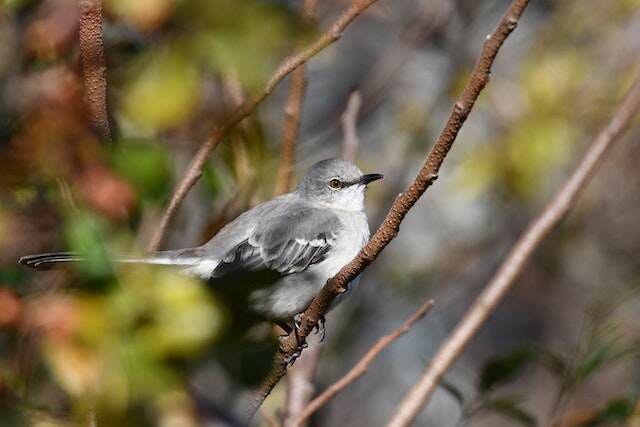
Threats and Conservation
Threats to the Northern Mockingbird’s survival
Despite its widespread distribution and adaptability, the Northern Mockingbird faces several threats to its survival. Habitat loss and fragmentation, caused by urbanization and agricultural expansion, pose a significant threat to the bird.
The use of pesticides and insecticides in agriculture also has a detrimental effect on the bird’s food sources, which consist mainly of insects and berries. Climate change is another threat, as it affects the availability of resources and may force the bird to adapt to new environments.
Other potential threats to the Northern Mockingbird’s survival include predation by domestic cats and collisions with vehicles and structures such as windows.
| Threats to the Northern Mockingbird’s survival | Description |
|---|---|
| Habitat loss and fragmentation | caused by urbanization and agricultural expansion |
| Use of pesticides and insecticides in agriculture | has a detrimental effect on the bird’s food sources |
| Climate change | affects the availability of resources and may force the bird to adapt to new environments |
| Predation by domestic cats | poses a potential threat |
| Collisions with vehicles and structures | such as windows, can also be a potential threat |
Conservation efforts
Several conservation efforts are underway to protect the Northern Mockingbird and its habitat. The bird is listed as a species of least concern by the International Union for Conservation of Nature (IUCN), but it is protected under the United States Migratory Bird Treaty Act.
The Act prohibits the hunting, capture, or possession of migratory birds, including the Northern Mockingbird, without a permit. The creation and protection of parks and natural reserves can help provide suitable habitat for the Northern Mockingbird.
Efforts to reduce pesticide and insecticide use can also benefit the bird’s food sources. Additionally, educating the public about the importance of the Northern Mockingbird and its habitat can help raise awareness and promote conservation.
How individuals can help protect the Northern Mockingbird
Individuals can also play a role in protecting the Northern Mockingbird. One way to help is to provide suitable habitat by planting native plants and trees that provide food and shelter for the bird. This can be done in backyards, parks, and other public spaces.
Reducing pesticide and insecticide use can also help protect the bird’s food sources. Another way individuals can help is to advocate for the creation and protection of natural reserves and wildlife corridors. These areas provide crucial habitat for the Northern Mockingbird and other wildlife.
Finally, individuals can also spread awareness about the Northern Mockingbird and its importance to the ecosystem. This can be done through social media, community events, and educational programs.
By raising awareness, individuals can help promote conservation efforts and protect the Northern Mockingbird for generations to come.
FAQs About The Florida State Bird: Northern Mockingbird
What is the Florida state bird?
The Florida state bird is the Northern Mockingbird, scientifically known as Mimus polyglottos. It was designated as the state bird of Florida in 1927.
Why was the Northern Mockingbird chosen as the Florida state bird?
The Northern Mockingbird was chosen as the Florida state bird because of its significant presence in the state throughout the year, as well as its beautiful songs and impressive mimicking abilities.
What does the Northern Mockingbird look like?
The Northern Mockingbird is a medium-sized songbird with a grayish-brown back and a pale gray chest and belly. It has white wing patches that are visible when it flies. Its long tail is edged with white feathers. Its beak is slender and slightly curved.
Where can I find the Northern Mockingbird in Florida?
The Northern Mockingbird can be found throughout Florida, from the panhandle to the Keys. It is a common sight in residential areas, parks, and gardens. It prefers open areas with short grass, but can also be found in wooded areas.
What does the Northern Mockingbird eat?
The Northern Mockingbird’s diet consists mainly of insects and berries. It is also known to eat small reptiles, fruit, and seeds. It is an omnivorous bird that feeds on a wide variety of food sources.
Is the Northern Mockingbird in danger?
While the Northern Mockingbird is not currently considered endangered, it faces several threats to its survival, including habitat loss, pesticide use, and climate change. Conservation efforts are in place to protect the bird and its habitat.
Conclusion
In conclusion, the Northern Mockingbird is a fascinating and beloved bird species in Florida, known for its beautiful songs and impressive mimicry abilities. However, it is also facing threats to its survival, including habitat loss and degradation, as well as threats from predators and human activity.
Through conservation efforts and individual actions, we can help protect and preserve the Northern Mockingbird for future generations to enjoy. Let us all work together to ensure the continued existence of this magnificent bird species.
Related Post:

